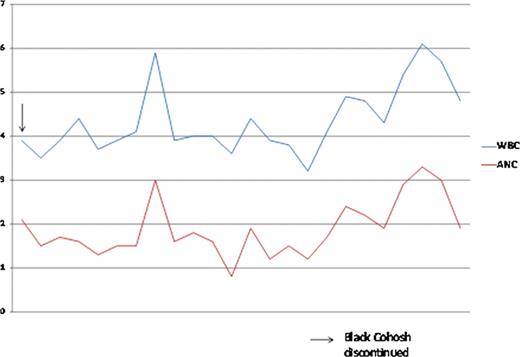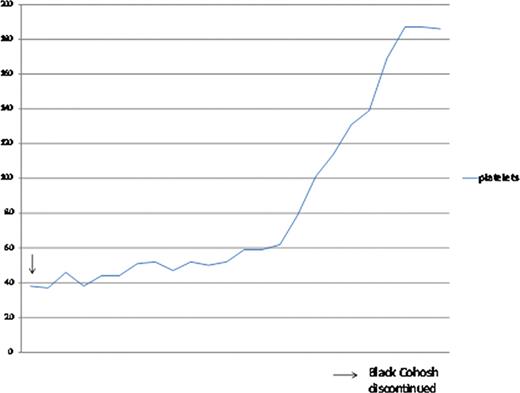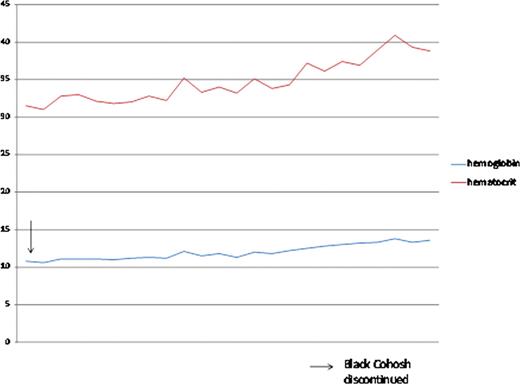Abstract
Abstract 4383
Black cohosh (known as both Actaea racemosa and Cimicifuga racemosa), a member of the buttercup family is a perrenial plant that is native of North America. It has been widely used to relieve premenstrual problems, menstrual cramps and to control hot flushes and other menopausal symptoms. The mechanism of action of the black cohosh is not fully understood. Here, we report the case of a patient with pancytopenia related to the use of the black cohosh.
A 58 year old female patient with past medical history of dyslipidemia, presented with bruising after several months of taking black cohosh. Her complete blood count revealed a white blood cell count of 3.1×109/L (normal 3.5–11 ×109/l), hemoglobin of 10.6 g/dl (normal 11–15 g/dl), hematocrit of 31 % (normal 32–45%), mean corpuscular volume of 109 fL (normal 80–98 fl), platelets count of 37 000/μL (normal 150000–400000/μL). Her medications included lipitor, black cohosh and vitamin D. Her physical exam was remarkable only for bruising. Serum protein electrophoresis did not show any evidence of a monoclonal spike and a coomb’s test was negative. She had normal immunoglobulins level, haptogloin, LDH, liver function tests, iron studies, vitamin B12 and folate. Her prothrombin and activated partial thromboplastin times were within reference range. Her peripheral smear showed macrocytic red blood cells and decreased platelets. Her bone marrow biopsy and aspirate showed a hypocellular bone marrow (cellularity of 25–30%), with a predominance of erythroid precursors that exhibit shift toward immaturity and mild to moderate megaloblastoid changes, moderately decreased myeloid precursors, slightly decreased megakaryocytes, and normal iron stores, there was no increase in the bone marrow blasts (0.6%). She also had a flow sent for paroxysmal nocturnal hemoglobinuria, which showed normal levels of expression of CD55 and CD59 of the neutrophils and the red cells. Upon presentation, the black cohosh was stopped. Following this, her white count, hemoglobin and platelets improved slowly (figures 1,2,3,) without any further interventions, but it took over 2 years for her counts to normalize.
Black cohosh is an over the counter herbal medicine that has been widely used by women to control premenstrual symptoms, menstrual cramping and menopausal symptoms. Many side effects have been described in the past but its effect on the bone marrow has never been studied. In our patient, Black cohosh caused pancytopenia that was reversible; however the recovery was very slow.
No relevant conflicts of interest to declare.
Author notes
Asterisk with author names denotes non-ASH members.




